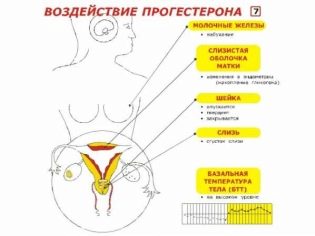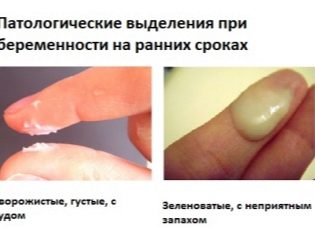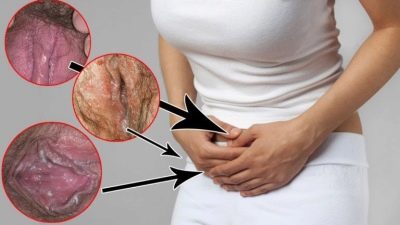White discharge during pregnancy
White discharge during pregnancy can be a completely normal phenomenon, and can warn of pathology. This type of discharge is most common and the expectant mother needs to know for sure when there is no reason for anxiety, and when urgent medical advice is needed. In this article we will explain what white discharge during pregnancy means and why they appear.
general characteristics
From the moment of fertilization of the egg in the body of the future mother begins a chain of interrelated and very important processes, the purpose of which is to create optimal conditions for the development of the fetus. These changes occur on the visible physical level and on the invisible eye - on the level of metabolism and hormonal restructuring. Vaginal secretion, which is produced by cervical epithelium cells, is an excellent indicator of the state of a pregnant woman, reflecting the essence of many processes, as well as possible pathologies.
In the early stages of discharge, they are thicker and scantier, but by the end of the first trimester they become more abundant, and subsequently watery. All these changes are dictated by the effects of certain hormones: at the beginning of pregnancy, by progesterone, and at the finish line, by estrogens. Organisms of pregnant women are very individual, but there are generally accepted norms of vaginal secretion, which should be guided by.
Normally, discharge during pregnancy should be light and homogeneous, without a strong odor, impurities of blood, pus. They should not give the future mother any physical discomfort. Light yellowish, lemon shades are acceptable - this color is due to the increased level of progesterone in the pregnant woman's body. All other colors and shades only sometimes can be considered the norm. For example, before delivery, the discharge may be brown, and at the earliest dates - pinkish.
The most frequent white discharge. They are quite diverse and can not always be considered normal and natural. In medicine, they are called whiter. And the development of such a vaginal secretion is called leukorrhea.
Types of whiter
Bleach can vary in quantity, consistency and hue. Most often during pregnancy there are moderate leucorrhoea, which does not cause cramps, burning, itching in the perineum, almost no odor. The permissible variant of the norm is whiter with a slight smell of sour milk or kefir. Also found are watery leucorrhoea, milky-white, blood (pink) and even greenish. Such whites do not have any relation to the norm and most often speak about the presence of diseases of the reproductive organs, pathologies of pregnancy, infections.
White discharge may have a different origin. So, bleach speaks about the inflammatory process in the fallopian tubes. Discharge with abundant, watery mixed with blood. In pregnancy, such secretions are rare. Uterine whites during pregnancy manifest in pregnant women with endometritis (including a history), as well as in the presence of tumors in the uterus. They are usually thicker, sometimes bubbling, with an unpleasant odor.
Cervical whites appear in diseases of the cervix uteri. In pregnancy, these may be genital infections, cervicitis caused by gonorrhea or chlamydia. Such whites usually contain a significant admixture of mucus. The most common during the childbearing vaginal leucorrhoea. They occur in response to hormonal changes.
If they are abundant, with impurities of blood or pus, we can talk about inflammation of the mucous membrane of the vagina.
There are also vestibular beli, they are associated with the intense activity of the sebaceous glands of the vulva. Such secretions appear in violation of the rules of intimate hygiene, as well as in pregnant women with diabetes and gestational diabetes.
With regard to whiter shade is always important. So, milk whites are considered a variant of the norm, as well as translucent. Thick, curdled, curdling, like fine granular curd, discharge - a sign of thrush caused by fungi of the genus Candida. Yellow and green shades indicate the presence of bacterial inflammation, mainly of a purulent character. All shades of pink, red and brown indicate the presence of blood in the linen.
Causes
The vaginal secret of white color which does not cause unpleasant sensations, by and large should not disturb the pregnant woman. Its profusion is not a reason for unrest, because under the influence of hormones that ensure the safety of pregnancy, the secretion of the cervix and vagina increases significantly.
Discharge is necessary to maintain a favorable microflora in the genital tract of the future mother. The body of the pregnant itself regulates the amount of discharge, so at some moments it may be more whiter, and at some less. These are the natural causes of white discharge.
With regard to the discharge of pathological, the most common causes may be as follows.
Fungal lesions, thrush
Typically, such discharge is accompanied by severe itching, a feeling of constant painful burning sensation in the perineum. Fungi, which are most often caused by thick curd whites - Candida, are very “loved” when their carrier's immunity decreases. Reduced immunity is quite natural for expectant mothers. From the earliest periods of gestation, progesterone suppresses the activity of a woman’s immunity so that he does not “deal” with the embryo. Immediately until birth, immunity remains reduced.
There is nothing surprising in the fact that for many women thrush makes itself felt not once or twice. Women even consider it a sign of pregnancy in the earliest terms, even before the onset of delay of the next menstruation. Also, thrush often manifests when a woman violates the rules and requirements of intimate hygiene.
To put up with discomfort is not necessary. With the appearance of white cheesy discharge with a sharp yeast odor and itching in the area of the external genital organs, a woman should definitely consult a doctor to receive antifungal treatment.
The appearance of thrush in late pregnancy is especially unpleasant. After all, in the presence of such a delicate problem, a woman will not be placed in the general ward of a maternity hospital, she will have to give birth and stay in the observational (infectious) department after giving birth. In addition, the likelihood that the baby, passing through the genital tract of the mother, does not catch the fungus, tends to zero. Fungal lesions of the eyes, skin, lips, respiratory tract are very dangerous for the newborn. Thrush must be treated immediately at any stage of pregnancy.
Inflammations and infections
With heavy white discharge (with the presence of a hue of any color or without it) you should also consult with your doctor if the discharge is combined with pain. On the inflammation of the organs of the female reproductive system can say cutting strong and less pronounced pain in the very lower abdomen - right or left, tingling in the cervix.Not necessarily, but sometimes a woman appears stinging and pain when urinating. Sex has only increased discomfort.
White discharge with an admixture of a greenish or yellowish hue may indicate a bacterial infection. Such secretions always have an unpleasant smell, which can be compared with the smell of spoiled fish.
Infections and inflammatory processes pose a great danger to the unborn child. The likelihood of intrauterine infection of the fetus, inflammation of the fetal membranes increases. Sometimes it can even lead to the death of the baby. Children born with intrauterine infections are very weak, their immunity is poorly coping with threats from the outside, often these children have anomalies and malformations that have arisen as a result of a long inflammatory process.
Ignore the abundant leucorrhoea of a watery and heterogeneous consistency with an unpleasant smell and additional symptoms of malaise in no case.
A woman should receive the necessary treatment as soon as possible - anti-inflammatory and antibacterial therapy may well be prescribed and performed at almost all stages of pregnancy, excluding the early embryonic period, when the organs and systems of the baby are laid.
Violation of the integrity of the fetal membranes
Liquid white discharge, translucent and rather abundant in the second half of pregnancy may indicate a leakage of amniotic fluid. If for some reason the integrity of the amnion is broken, the waters begin to flow and mix with the vaginal secretion. Such secretions may not be accompanied by any additional symptoms.
The secretion becomes more abundant if the woman experiences physical exertion, during movement, lifting weights, as well as when the body position changes from horizontal to vertical. Water leakage is very dangerous - when the amount of amniotic fluid reaches a critical value, the baby may begin to experience discomfort, hypoxia, his physical activity will decrease to a minimum.
Today, special amniotests are available in pharmacies that allow you to determine if there is an admixture of amniotic fluid in the secretions. However, their accuracy leaves much to be desired.
Therefore, in case of suspected amniotic fluid leakage, it is better to immediately go to a medical institution to determine the fact through ultrasound and laboratory tests of the vaginal secretions.
Allergic reaction
This reason is less common than others, but it also has a place to be. White secretions of an atypical character may appear during pregnancy in response to the body's immune response to antigen proteins. Allergies to intimate care products, soap, and some types of daily sanitary pads used by women are most commonly experienced.
Leucorrhea with allergies are not abundant, rather, their number decreases, but the consistency becomes thicker. Beli are heterogeneous in structure. Additional symptoms may include slight itching, redness of the external genital organs, discomfort when walking.
This situation requires a correction approach to hygiene. A woman should wash her face with boiled water without using soap at all, do not wipe her genitals with a hard towel, do not wear close and crushing underwear, refuse to wear synthetic and semi-synthetic fabrics. Be sure to change the gaskets to similar, but different, more time-tested and consumer brands.
Mom's local allergy does not threaten the unborn child. However, it is still necessary to be treated. After eliminating the source of allergens, antihistamines are usually given to the woman to eliminate the symptoms of sensitization.
Microflora imbalance
A special microclimate is maintained in the female genital tract.Any negative factors of external or internal origin can disrupt it. So, vaginal dysbiosis can be observed with the habit of doing douching, including decoction of medicinal plants. Some pregnant women practice such methods as preparation for childbirth, naively believing that they are carrying out sanitation of the genital tract by folk methods. The result is usually the opposite. The microflora is disturbed, frothy whites appear, more or less dense.
A cold, hypothermia, influenza and ARVI, as well as some foods, such as yeast dough, pastry, non-alcoholic beer, home brew, cottage cheese, if consumed in large quantities, can affect the microclimate of the genital tract. The use of intimate gels and lubricants-lubricants during sex has a negative effect on the state of the microflora of the genital tract.
Refer to the doctor will help to establish the nature and extent of the violation. A smear from the vagina on the microflora will give a detailed picture of the processes taking place. Symptomatic treatment is prescribed. The factor that caused the violations is necessarily eliminated.
General recommendations for expectant mothers
It is necessary to control the nature of secretions during pregnancy for all women, even if their pregnancy proceeds smoothly and without visible complications. The main assistant to the future mother - daily pads. It is forbidden to use tampons while waiting for the baby, since the vaginal secretion must necessarily move outside freely, otherwise inflammation cannot be avoided.
Any changes should be regarded by the woman as an alarming symptom. Only a doctor can answer the question whether everything is in order. Answers to it do not need to ask on the forums on the Internet.
The other extreme of pregnant women is heightened suspicion. Some in search of non-existent pathology bring themselves and their doctor to nervous exhaustion.
In order not to fall into such an extreme, it is important to remember that normal discharge is never accompanied by an unpleasant odor, pain and other discomfort, and pathological never appear asymptomatic.
For information on what should be alerted women, see the following video.




























